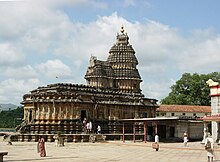 Sringeri Sharada Peetham logo | |
 Vidyashankara Temple at Sringeri completed in 1338 | |
| Founder | Adi Shankaracharya |
|---|---|
| Location |
|
| Coordinates | 13°24′59″N 75°15′07″E / 13.416519°N 75.251972°E |
First Shankaracharya | Sri Sureshvaracharya |
Present Shankaracharya | Jagadguru Shankaracharya Sri Sri Bharati Tirtha Mahasannidhanam |
| Website | https://www.sringeri.net/ |

| Part of a series on |
| Advaita |
|---|
 |
|
|
Dakṣiṇāmnāya Śrī Śāradā Pīṭham (IPA: [d̪ɐkʂiɳaːmn̪aːjɐ ɕriː ɕaːrɐd̪ɐ piːʈʰɐm]) or Śri Śṛṅgagiri Maṭha (IPA: [ɕriː ɕr̩ŋɡɐɡiri mɐʈʰɐ]); Sanskrit: मठ, maṭha) is one amongst the four cardinal pīthams following the Daśanāmi Sampradaya - the peetham or matha is said to have been established by acharya Śrī Ādi Śaṅkara to preserve and propagate Sanātana Dharma and Advaita Vedānta, the doctrine of non-dualism. Located in Śringerī in Chikmagalur district in Karnataka, India, it is the Southern Āmnāya Pītham amongst the four Chaturāmnāya Pīthams, with the others being the Dvārakā Śāradā Pītham (Gujarat) in the West, Purī Govardhana Pīṭhaṃ (Odisha) in the East, Badri Jyotishpīṭhaṃ (Uttarakhand) in the North.[1] The head of the matha is called Shankarayacharya, the title derives from Adi Shankara.
Śri Śringerī Mutt, as the Pītham is referred to in common parlance, is situated on the banks of the Tuṅgā River in Śringerī. The Mutt complex consists of shrines on both the northern and southern banks of the river. The three prominent shrines on the northern bank of the Tunga are dedicated to the presiding deity of the Pītham and the divinity of Ātma-vidyā - Śrī Śāradā,[2] Śrī Ādi Śaṅkara,[3] and Jagadguru Śrī Vidyāśankara Tīrtha,[4][5] the 10th Jagadguru of the Pītham. The southern bank houses the residence of the reigning pontiff, the adhisthānam shrines of the previous pontiffs and the Sadvidyā Sañjīvini Samskrita Mahāpāthashālā.
The Pītham is traditionally headed by an ascetic pontiff belonging to the order of the Jagadguru Śankarāchārya. According to tradition, the first pontiff of the Pītham was Śrī Ādi Śaṅkara's eldest disciple, Śrī Sureshvarāchārya,[6] renowned for his treatises on Vedānta - Mānasollāsa and Naishkarmya-Siddhi. The current pontiff, Śrī Bhārathī Tīrtha Svāmin is the 36th Jagadguru in the since-unbroken spiritual succession of pontiffs.[7]
The Pītham is one of the major Hindu institutions that has historically coordinated Smārta tradition and monastic activities through satellite institutions in South India, preserved Sanskrit literature and pursued Advaita studies.[8] The Pītham runs several vedic schools (pathashalas), maintains libraries and repositories of historic Sanskrit manuscripts.[9][10][11] The Śringerī Mutt has been active in preserving Vedas, sponsoring students and recitals, Sanskrit scholarship, and celebrating traditional annual festivals such as Śaṅkara Jayanti and Guru Purnima (Vyāsa Pūrnima).[12] The Pītham has branches across India and maintains temples at several locations.[13] It also has a social outreach programme.[14]
- ^ J. Gordon Melton (2014). Faiths Across Time: 5,000 Years of Religious History. ABC-CLIO. pp. 574–575. ISBN 978-1-61069-026-3.
- ^ "Sri Sharadamba". Sringeri Sharada Peetham. Retrieved 25 June 2020.
- ^ "Sri Adi Shankaracharya". Sringeri Sharada Peetham. Retrieved 25 June 2020.
- ^ "Sri Vidyashankara". Sringeri Sharada Peetham. Retrieved 25 June 2020.
- ^ "Vidyashankara Temple | Sharada Peetham". Karnataka.com. 22 June 2011. Retrieved 25 June 2020.
- ^ "Sri Sureshwaracharya". Sringeri Sharada Peetham. Retrieved 26 June 2020.
- ^ "Jagadgurus". Sringeri Sharada Peetham. Retrieved 26 June 2020.
- ^ Anna Libera Dallapiccola; Stephanie Zingel-Avé Lallemant (1985). Vijayanagara-city and empire: new currents of research. Steiner Verlag Wiesbaden. pp. 130–137. ISBN 978-3-515-04554-4.
- ^ "Sustenance of Sanatana Dharma". Sringeri Sharada Peetham. Retrieved 26 June 2020.
- ^ David Pingree (1981). Census of the Exact Sciences in Sanskrit. American Philosophical Society. pp. 55–56, 250–260, 317, 410. ISBN 978-0-87169-146-0.
- ^ AK Shastri 1999, pp. 10–11.
- ^ Borayin Larios (2017). Embodying the Vedas: Traditional Vedic Schools of Contemporary Maharashtra. Walter De Gruyter. pp. 75–77. ISBN 978-3-11-051732-3.
- ^ "Branches". Sringeri Sharada Peetham. Retrieved 26 June 2020.
- ^ "Social Activities". Sringeri Sharada Peetham. Retrieved 26 June 2020.